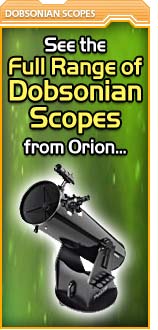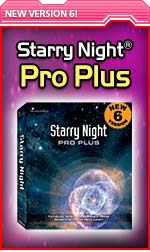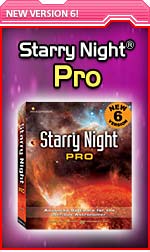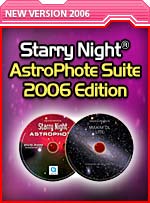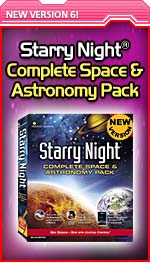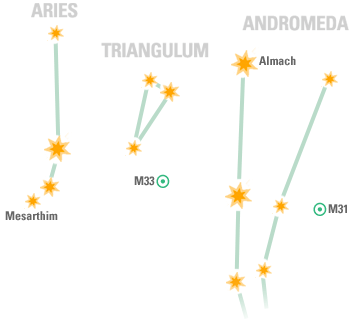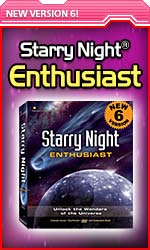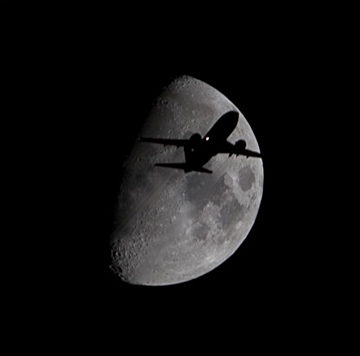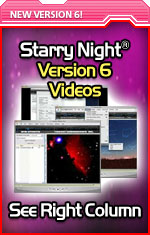 |
||||||||||||||||||||||||||||||||||||||||||||||||||||||||||||||||||||
|
If you have trouble viewing this newsletter, click here. Welcome again to our monthly newsletter with features on exciting celestial events, product reviews, tips & tricks, and a monthly sky calendar. We hope you enjoy it!
Astronauts on board the International Space Station (ISS) unfurled a new pair of solar energy panels that sprout out of the end of a new 17.5-ton truss section, which was brought up by the space shuttle Atlantis. They are the largest solar panels ever taken to space; fully unfolded, they reach a length of 240 feet (73 meters). They are designed to double the ISS’s capability to generate power from sunlight when they go online during a future shuttle mission. The panels are made of layers of thin gold Mylar plastic, which are highly reflective.
How bright? Like other satellites, the ISS shines by virtue of sunlight reflected off of its metallic skin. The station orbits approximately 213 miles (341 kilometers) above Earth. Before the ISS spread its new pair of gold wings, it was already the brightest of all space vehicles, at times appearing to shine with a brilliance equal to the planet Jupiter. Now skywatchers should notice the orbiting outpost glowing with an even greater luster. Nobody knows exactly how much brighter it will be, but there’s a good chance that it could be brighter than magnitude -3, approaching the glow of Venus, the brightest planet. On this astronomers' scale, smaller numbers denote brighter objects, and negative numbers are reserved for the handful of the very brightest. And the ISS will likely get even brighter. The solar panels are only the second of four planned arrays that will be deployed between now and before the shuttle fleet is retired in the year 2010. To read the rest of this article, click here.
On August 24, 2006, the International Astronomical Union (IAU) demoted Pluto to the new category of “dwarf planet”. To add insult to injury, the Minor Planet Center gave Pluto a number – 134340 – just like any lowly asteroid. But before we get too emotional, let’s consider the following: In the beginning there were seven planets: the Sun, the Moon, Mercury, Venus, Mars, Jupiter and Saturn. Then, in 1543, Copernicus upset the apple cart and promoted the Sun to a special position. The Moon, however, became a mere satellite of the “new” planet Earth. Alas, poor Moon! So now, we had six planets. Herschel’s discovery of Uranus in 1741 made it seven and Piazzi’s discovery of Ceres in 1801 gave us a total of eight planets. Admittedly, Ceres seemed to be extremely small but it fit nicely into the empty gap between Mars and Jupiter. But then the floodgates opened. By the mid-nineteenth century, fourteen more very small “planets” were discovered in addition to huge Neptune. This was too much for astronomers. Neptune was far beyond the orbit of Uranus and similar in size but what about all those smaller objects? They all shared the space between Mars and Jupiter and more were sure to be discovered. Thus in 1852, Ceres and her fourteen siblings were demoted to “asteroids”. Alas, poor Ceres (and 14 others)! The solar system had now shrunk from 23 to 8 planets. To read the rest of this article, click here.
My
new
Orion
XT10
arrived
in
three
boxes,
the
biggest
of
which
would
only
barely
fit
into
my
Toyota
Echo
hatchback.
I
had
been
anticipating
the
arrival
of
my
scope
for
a
couple
of
days
and
was
delighted
to
have
received
it.
As
I
negotiated
the
stairs
up
to
my
front
door
with
the
largest
of
the
packages,
I
couldn't
help
but
consider
that
I
was
responsible
for
the
impending
downpour.
It is widely accepted that I am the "Anti-Handyman" with only minimal assembly skills. My wife Gwen usually makes herself scarce whenever I take on projects with screwdrivers and drills, out of concern for her delicate sensibilities and her respect of the fact that I have to win in the battle against the bad thing that is fighting me. Yes, the difficulty level of my attempted projects is usually measured in curse words. These days, with a nine year old in the house, the curse words have been replaced with the Flintstones equivalents such as "Frazamazta","Dookentoble" and "Krazellbatz". The hardest projects get a five "Frazamazta" rating. Luckily, the good folks at Orion Telescopes have a decent set of instructions to follow and, being a long weekend, I took my time. Only an hour went by before I had a telescope. This evening, a hole opened in the clouds. I hurried down the steps as best I could carrying a huge telescope tube almost as big as myself. Within a couple of minutes I was good to go. What would be my first object? My skies were blocked except for mostly overhead. I opted for a famous double star called Albireo. As I swung the tube around I relished the thought of the ten inch mirror catching the light of the beautiful pair of stars - one blue and one orange... ...I'm still looking forward to seeing them, once the clouds part. Maybe I'll be lucky on Thursday. Steve
Bevan Reprinted
courtesy
yorkregion.com. |
October 2006
|
|||||||||||||||||||||||||||||||||||||||||||||||||||||||||||||||||||
|
With pleasant autumn evenings arriving, many people may be thinking of buying a telescope. There’s a lot of bad advice out there; here are some samples, counterbalanced with the facts. Myth: Magnification is a good way to judge a telescope Reality: Any telescope that has interchangeable eyepieces can produce any magnification. The useful magnification on a telescope is much more limited, and depends on the size of the telescope’s aperture (diameter of lens, mirror, or corrector plate). A telescope with 60mm aperture has a range of useful magnifications from about 12x to 120x, no matter what the advertising on the box may say. And a larger telescope, such as an 8” reflector, will have a larger, but still limited range, 40x to 300x. Unless you live in a place with very stable air, such as Florida, 300x will be your upper limit on magnification no matter how big your telescope is. The best way to compare telescopes is by their aperture. By and large, a telescope with a larger aperture will outperform a telescope with a smaller aperture on every kind of object. The main counterbalancing factors are size, weight and cost. If a telescope is too large to be set up conveniently, it won’t be used as often as a smaller, more convenient scope. To read the rest of this article, click here. |
||||||||||||||||||||||||||||||||||||||||||||||||||||||||||||||||||||
|
I’m a visual astronomer. I’ve tried astrophotography a few times, but have never been very happy with the results or willing to put in the time and money necessary to improve them. I’ve pretty much come to think of astrophotography as the rich man’s end of the hobby. But the appearance of relatively inexpensive (under $100) devices for acquiring images of solar system objects recently attracted my attention, and made me decide to give it another try.
To read the rest of this article, click here. |
An unbeatable introductory package for astrophography! |
|||||||||||||||||||||||||||||||||||||||||||||||||||||||||||||||||||
|
Digital Institute 06 The second annual Digital Institute was hosted by Spitz Inc. in historic Chadds Ford, PA. During the expanded five day Institute, participants explored astronomy education, presentation and production techniques using Starry Night® and other digital tools. Courses covered a broad range of digital planetarium topics from basic techniques and terminology, to advanced lesson creation with 3D simulation software, to advanced-user sessions.
The nearly 30 attendees of the Digital Institute focused on using software to enhance education in both the classroom and the planetarium. To set up a Starry Night® Training Day for your school district, please contact Mike Goodman at <mgoodman@imaginova.com>.
Starfest 2006 Starfest is Canada's largest annual observing convention and star party. It attracts over nine hundred astronomy enthusiasts from Ontario, and neighboring provinces and states. It has been ranked among the top seven star parties in North America by Sky and Telescope magazine. To read the rest of this article, click here. |
|
|||||||||||||||||||||||||||||||||||||||||||||||||||||||||||||||||||
|
Triangulum is well placed at this time of year for observations of M33, a spiral galaxy. However, at 2.4 million light years and only 5% as massive as our own galaxy, it's a dim fuzzy object in 8" scopes and requires good dark skies to show any detail. Follow a line from M33 through Mirach in Andromeda to find the brightest spiral in the sky, M31, the Andromeda Galaxy as well as its satellite galaxies M32 and M110. As with M33, the photons from M31 have travelled 2.4 million years to pass through the pupil of your eye and end their journey on your retina. The Andromeda Galaxy is also one of the few galaxies that's blue-shifted, meaning that is traveling toward us: almost all others are red-shifted and speeding away. Once you've found M31 with the aided eye, you can practice picking it out with the naked eye. You can then congratulate yourself that no-one can see any farther than you–the barely visible faint smudge you can just make out is the farthest object visible to the unaided eye. At the tip of the constellation's brightest limb, is Almach (Gamma Andromedae) a very sweet orange/blue double. And finally, below Triangulum, in Aries, is Mesarthim (Gamma Aries) another lovely double, orange/green, sitting 207 light years away with an angular separation of 7.5". Sean
O'Dwyer
|

|
|||||||||||||||||||||||||||||||||||||||||||||||||||||||||||||||||||
|
David Wellwood used his Canon EOS 20D digital camera to capture an aircraft passing in front of the Moon. Focal Length: 280mm - Shutter Settings: 1/200 sec, f/5.6. David writes: Good photos of aircraft in front of the moon at night are hard to get. I took this one by waiting until the moon was in the ‘Big Sur Two’ arrival pattern into SFO airport to improve my chances, then watching patiently until I got lucky. You can see the distortions caused by the hot engine exhaust. PHOTO OF THE MONTH COMPETITION: We would like to invite all Starry Night® users to send their quality astronomy photographs to be considered for use in our monthly newsletter. Featured submissions (best of month) will receive a prize of $25 USD. Please read the following guidelines and see the submission e-mail address below.
|

|
|||||||||||||||||||||||||||||||||||||||||||||||||||||||||||||||||||
 |
||||||||||||||||||||||||||||||||||||||||||||||||||||||||||||||||||||
|
*Save $20 off Version 6 Upgrades! To redeem your $20 instant savings on your Starry Night® Enthusiast version 6 upgrade, Pro version 6 upgrade, Pro Plus version 6 upgrade or AstroPhoto Suite (2006 edition) upgrade, you must enter coupon code sn20v6 in the coupon code field of the Starry Night® shopping cart (the coupon code field appears on the Payment Page of the shopping cart. ) The discounted price will only appear in the Starry Night® shopping cart but not on the product detail page. Minimum purchase of $45.00 USD is required. Offer expires September 30, 2006 11:59 pm EST. Not valid on previous purchases. |
||||||||||||||||||||||||||||||||||||||||||||||||||||||||||||||||||||
You
have
received
this
e-mail
as
a
trial
user
of
Starry
Night®
Digital
Download
or
as
a
registrant
at
starrynight.com.
To
unsubscribe,
click
here.


